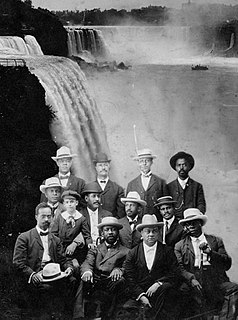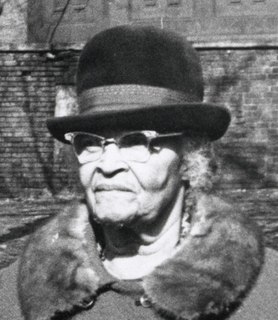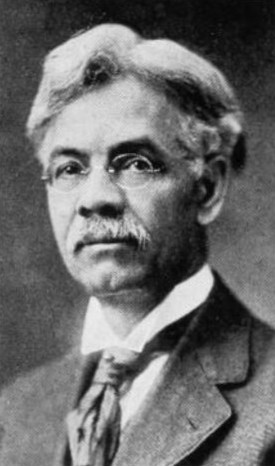
The Niagara Movement (NM) was a black civil rights organization founded in 1905 by a group of activists—many of whom were among the vanguard of African-American lawyers in the United States—led by W. E. B. Du Bois and William Monroe Trotter. It was named for the "mighty current" of change the group wanted to effect and took Niagara Falls as its symbol. The group did not meet in Niagara Falls, New York, but planned its first conference for nearby Buffalo.

William Monroe Trotter, sometimes just Monroe Trotter, was a newspaper editor and real estate businessman based in Boston, Massachusetts. An activist for African-American civil rights, he was an early opponent of the accommodationist race policies of Booker T. Washington, and in 1901 founded the Boston Guardian, an independent African-American newspaper he used to express that opposition. Active in protest movements for civil rights throughout the 1900s and 1910s, he also revealed some of the differences within the African-American community. He contributed to the formation of the National Association for the Advancement of Colored People (NAACP).

Archibald Henry Grimké was an American lawyer, intellectual, journalist, diplomat and community leader in the 19th and early 20th centuries. He graduated from freedmen's schools, Lincoln University in Pennsylvania, and Harvard Law School and served as American Consul to the Dominican Republic from 1894 to 1898. He was an activist for rights for blacks, working in Boston and Washington, D.C. He was a national vice-president of the National Association for the Advancement of Colored People (NAACP), as well as president of its Washington, D.C. branch.

J.R. Clifford was West Virginia's first African-American attorney. Clifford was also a newspaper publisher, editor and writer, school teacher, and principal. He was a Civil War veteran, grandfather, as well as a civil rights pioneer and founding member of the Niagara Movement. Despite boundaries derived from racial discrimination, Clifford's accomplishments were great, reflecting his ability and determination.

The William Lloyd Garrison House, also known as Rockledge, is a National Historic Landmark house, located at 125 Highland Street in the Roxbury Highlands section of Boston, Massachusetts. Probably built in the 1840s or 1850s, it is significant as the longtime home of William Lloyd Garrison (1805–1879), one of the most high-profile abolitionist activists of the mid-19th century United States. Garrison published The Liberator, the principal organ of the abolitionist movement, and spoke for the immediate emancipation of slaves. Despite significant later alterations to accommodate institutional uses, the building has retained much of its 19th-century fabric. It was designated a National Historic Landmark in 1965 and is a pending Boston Landmark.

Melnea Agnes Cass was an American community and civil rights activist. She was deeply involved in many community projects and volunteer groups in the South End and Roxbury neighborhoods of Boston and helped found the Boston local of the Brotherhood of Sleeping Car Porters. She was active in the fight to desegregate Boston public schools, as a board member and as president of the Boston chapter of the National Association for the Advancement of Colored People (NAACP). As a young woman, Cass also assisted women with voter registration after the passage of the Nineteenth Amendment. She was affectionately known as the "First Lady of Roxbury."
The National Equal Rights League (NERL) is the oldest nationwide human rights organization in the United States. It was founded in Syracuse, New York in 1864 dedicated to the liberation of black people in the United States. Its origins can be traced back to the emancipation of slaves in the British West Indies in 1833. The league emphasized moral reform and self-help, aiming "to encourage sound morality, education, temperance, frugality, industry, and promote everything that pertains to a well-ordered and dignified life." Black leaders formed state and local branches of the league which drew many members, which caused the society to grow quickly, in areas such as Harrisburg, Pennsylvania, where people such as Thomas Morris Chester joined.

The Robert Russa Moton Museum is a historic site and museum in Farmville, Prince Edward County, Virginia. It is located in the former Robert Russa Moton High School, considered "the student birthplace of America's Civil Rights Movement" for its initial student strike and ultimate role in the 1954 Brown v. Board of Education case desegregating public schools. It was designated a National Historic Landmark in 1998, and is now a museum dedicated to that history. In 2022 it was designated an affiliated area of Brown v. Board of Education National Historical Park. The museum were named for African-American educator Robert Russa Moton.

Maria Louise Baldwin was an American educator and civic leader born in Burlington and raised in Cambridge, Massachusetts. She lived all her life in Cambridge and Boston. Writing in 1917, W.E.B. Du Bois claimed she had achieved the greatest distinction in education to that time of any African-American not working in segregated schools.

The Maria Baldwin House is a National Historic Landmark located at 196 Prospect Street, Cambridge, Massachusetts, United States. The house is the northern half of a 19th-century two-family house, notable for its associations with educator Maria Louise Baldwin (1856–1922). It was her home when she served as the first female African-American principal in a Massachusetts school at Cambridge's Agassiz Grammar School. As master, she supervised 12 teachers, all white, who presided over a 98% white student body. The Agassiz School has since been renamed the Maria Baldwin School in her honor. The Baldwin House was declared a National Historic Landmark in 1976.

The Ida B. Wells-Barnett House was the residence of civil rights advocate Ida B. Wells (1862–1931) and her husband Ferdinand Lee Barnett from 1919 to 1930. It is located at 3624 S. Dr. Martin Luther King Jr. Drive in the Douglas community area of Chicago, Illinois. It was designated a Chicago Landmark on October 2, 1995. It was listed on the National Register of Historic Places and as a National Historic Landmark on May 30, 1974.

The James Weldon Johnson Residence is a historic apartment house located at 187 West 135th Street, Harlem, Manhattan, New York City, New York. It is here where James Weldon Johnson (1871-1938) lived from 1925 until his death. In addition to being a composer, songwriter, and author, he was an outspoken advocate for civil rights, working in various roles at the NAACP, including as its General Secretary during his residency here. The building was declared a National Historic Landmark in 1976.
The Boston Guardian was an African-American newspaper, co-founded by William Monroe Trotter and George W. Forbes in 1901 in Boston, Massachusetts, and published until the 1950s.

William Hickling Prescott House, also known as the Headquarters House, is an historic house museum located at 55 Beacon Street on Beacon Hill in Boston, Massachusetts. It is the left-hand portion of a double townhouse at 54–55 Beacon Street, seen in the photograph. The townhouse, built in 1808 to a design by Asher Benjamin, was designated a National Historic Landmark in 1964 for its association with William Hickling Prescott (1796–1859), one of the nation's first historians. The house is now a museum operated by the Massachusetts chapter of the National Society of the Colonial Dames of America, which purchased it for its headquarters in 1944.

The W.E.B. Du Bois Boyhood Homesite is a National Historic Landmark in Great Barrington, Massachusetts, commemorating an important location in the life of African American intellectual and civil rights activist W.E.B. Du Bois (1868–1963). The site contains foundational remnants of the home of Du Bois' grandfather, where Du Bois lived for the first five years of his life. Du Bois was given the house in 1928, and planned to renovate it, but was unable to do so. He sold it in 1954 and the house was torn down later that decade.
Geraldine Pindell Trotter (1872–1918) was an American civil rights activist and editor. Pindell Trotter was an integral fixture of Boston's African-American upper class at the turn of the 20th century. Pindell Trotter is most known for her role as the associate editor of George W. Forbes's and her husband William Monroe Trotter's newspaper, the Boston Guardian.
A Boston Landmark is a designation by the Boston Landmarks Commission for historic buildings and sites throughout the city of Boston based on the grounds that it has historical, social, cultural, architectural or aesthetic significance to New England or the United States. While National Landmark or National Register status can provide tax incentives for the owner of an income-producing property, local landmark status provides more control over modifications to a designated historic structure or place.

Butler Roland Wilson (1861–1939) was an attorney, civil rights activist, and humanitarian based in Boston, Massachusetts. Born in Georgia, he came to Boston for law school and lived there for the remainder of his life. For over fifty years, he worked to combat racial discrimination in Massachusetts. He was one of the first African-American members of the American Bar Association. Wilson was a founding member and president of the Boston branch of the National Association for the Advancement of Colored People (NAACP).

Clement Garnett Morgan (1859-1929) was an American attorney, civil rights activist, and city official of Cambridge, Massachusetts. Born into slavery in Virginia and freed by the Emancipation Proclamation, he trained as a barber before moving to Massachusetts to pursue his education. He was the first African American to earn degrees from both Harvard University and its law school; the first African American to deliver Harvard's senior class oration; and the first black alderman in New England. As an attorney he handled many civil rights cases, in one instance closing down a segregated school. He was a founding member of the Niagara Movement and of the Boston branch of the National Association for the Advancement of Colored People.

George W. Forbes (1864-1927) was an American journalist who advocated for African-American civil rights in the late 19th and early 20th centuries. He is best known for co-founding the Boston Guardian, an African-American newspaper in which he and William Monroe Trotter published editorials excoriating Booker T. Washington for his accommodationist approach to race relations. He also founded and edited the Boston Courant, one of Boston's earliest black newspapers, and edited the A. M. E. Church Review, a national publication.




















